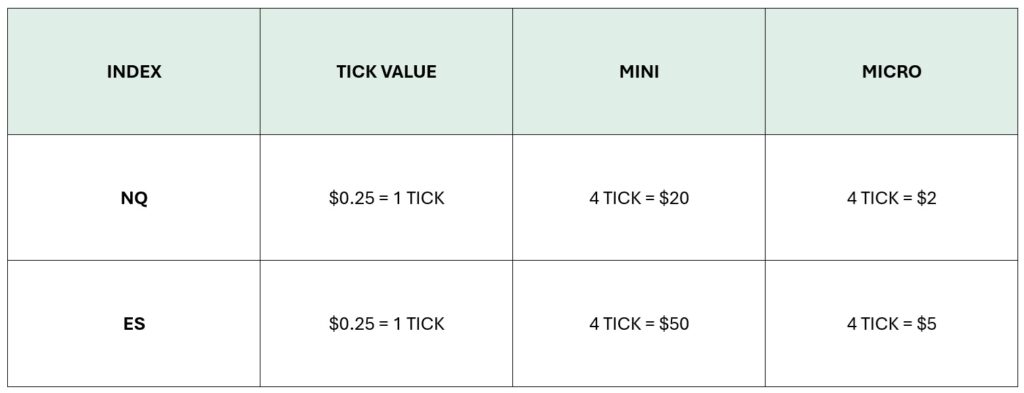
Day trading has always been an intriguing challenge for me. From 2021 until now, I’ve been exploring the arena of day trading with options and futures. I liked the idea of not holding the trades for more than a few hours to reduce any potential overnight risk. I learned there are many ways to make money in the US stock market and saw the potential of day trading as a method of replacing my income one day. After a couple of years of trial and error, I’ve finally found a trading strategy that works really well for me. On this page and in future blog posts, you can follow my journey in day trading. All the things I’ve learned to grow my account will hopefully help grow your account as well.
Getting Started
What are Futures?
Futures are contracts that were created for the agricultural industry in order for farmers to secure a good price on produce and meat. Kind of like a raincheck. As the buyer of the raincheck, you are obligated to buy the product at the set price on the expiration day that’s stated in your contract. As the seller, you are required to deliver the product on the expiration date in exchange for money.
As the futures market became popular, non-food products were also added to the exchange, such as energy, commodities, stock market index, currency, and precious metals. Speculators and traders use these products to invest, trade, and make money.
The basic trading philosophy of stocks, options, and futures is simple. In order to make money, you must buy low and sell high, or sell high and buy low.
Both futures and options have contracts that expire, and each contract is leveraged, so you have the ability to take more risk at a lower price. Where it differs is that futures are a lot less complicated compared to options. Market volatility and expiration dates do not affect the underlying value of the contract. Where the money is made is by trading those contracts and not holding them until expiration.
Fun fact: If you bought and held an agricultural futures product, like corn, and let the contract expire, you will be expected to pay for the corn, and it will be ready for you to pickup at one of the delivery terminals.
Why use Futures in Day Trading?
Trading options is great and the barrier to entry is low however, it is a steep learning curve and requires at least $2000USD of margin to start trading. On the other hand, learning to trade futures is a lot easier to understand and you can trade using online prop firms risking only $30-$50USD per month to start. Prop (or Proprietary) firms are companies that offer their traders the opportunity to make money by trading with the company’s money. The company will take a 10-20% cut of your profits in exchange for allowing you to use a large amount of their money to trade. What’s great about prop firms is that your risk is small while the opportunity to make money is exponential. This is how you can replace your full-time job.
Which Futures products Trade?
There are many products on the futures market to trade however my favourite is the NASDAQ index. This product has been around since 1971 and contains more than 3000 securities within focusing heavily on tech stocks. Because the NASDAQ index is so large, only large institutions were able to trade it. To make NASDAQ more accessible to the average person, the CME corp created the NASDAQ or NQ E-mini was created which is a fraction of the index. Then the micro NQ or MNQ which is 1/10th the size of the underlying index was created for even smaller accounts to trade it. The price movement the NQ is dynamic and brings a lot of movement in the market which means greater opportunity to make money. The minis work well for larger accounts however don’t underestimate the micros. With consistency and the trade copier among multiple accounts, the micros can provide a healthy income that can totally replace your income. Take a look at how the nasdaq futures are leveraged.

Which Prop Firm to use?
Keeping your goals attainable is key. While in theory, managing a $150,000 account sounds amazing, hitting a profit target of $9000 is daunting for a beginner. These prop firms charge a monthly fee until you pass their evaluation, so the best-case scenario is to choose a small account and trade small. Treat this as your small business if you want to make it your full-time job and scale up over time. I recommend choosing the $10,000 or $25,000 account.
The prop firms recommended below allow for you to have multiple accounts in which you can copy your trades across all these accounts to trade more contracts while not increasing your risk. The prop firms below are the platforms that I currently trade on as of now (updated on Sept. 2024)
- Apex Trader Funding
Note: Always trade with a simulation account before purchasing an account with a prop firm. All prop firms have major sales during holidays, always purchase at a discounted price
I’m currently working on trading with 2 evaluation accounts hoping to get funded within 60 days. I’m also not stressed if it takes me more than 60 days. Both accounts were bought with discounts.
My Plan: To have one account fully funded account by 60 days. Then continue to purchase more accounts until I’ve reached 20 accounts with Apex Trader Funding.
My favourite strategy to use is the 15min Opening Range Break out. See my blog post here on how I trade to pass my evaluation accounts.
Happy Trading👩💻
-the wealthy sheep
Leave a Reply